Your oven's temperature fluctuations likely stem from several common issues that affect its heating performance. A faulty thermostat or temperature sensor can cause inaccurate readings, while a worn door seal lets heat escape. You might have a malfunctioning heating element that's not distributing heat properly, or your ventilation system could be blocked, preventing proper air circulation. The electronic control board might also be failing, leading to inconsistent temperature regulation. Regular maintenance, including cleaning vents and checking seals, can help prevent these issues. Understanding these potential problems will help you pinpoint the exact cause of your oven's temperature troubles.
Common Temperature Control Problems
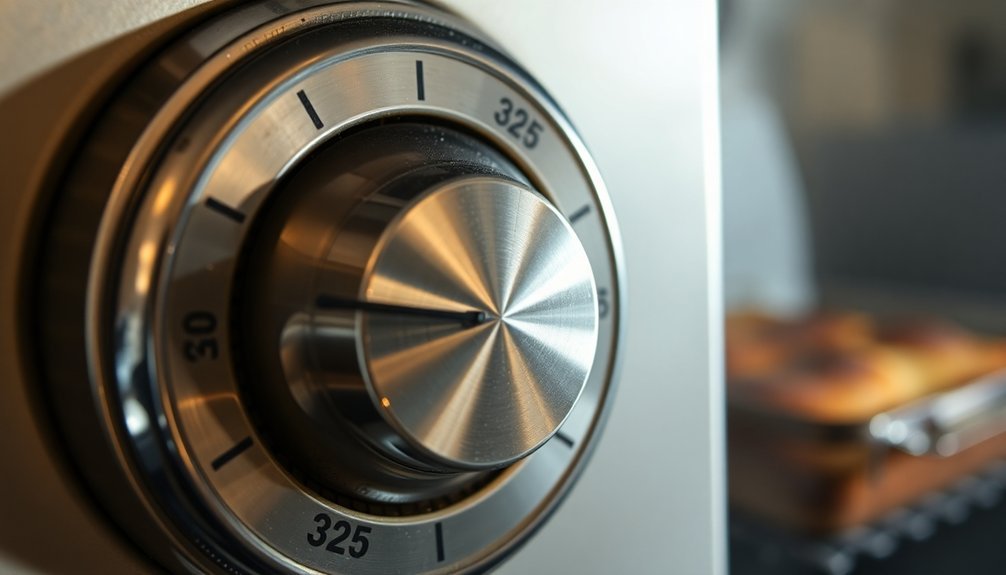
Throughout your oven's lifespan, you'll likely encounter several temperature control issues that can affect your cooking results. A broken thermostat is often the primary culprit, as it fails to regulate temperature properly, resulting in burnt or undercooked food.
If you notice significant temperature fluctuations, you'll need to test your oven with a thermometer and potentially replace the thermostat. A loose door seal can allow heat to escape, leading to inconsistent cooking temperatures.
Element damage can also cause temperature inconsistencies, particularly when one side of your oven becomes hotter than the other. You'll need to replace damaged elements with model-specific parts to restore even heat distribution.
Similarly, a malfunctioning cooling fan can lead to substantial temperature variations, as it's essential for maintaining consistent heat levels during cooking.
Your oven's temperature sensor and calibration settings might also be responsible for inconsistent temperatures. If your oven's reading is off by more than 25 degrees Fahrenheit, you'll need to recalibrate the thermostat by adjusting the notched plate behind the control knob.
Regular testing with an oven thermometer can help you identify these issues early and determine whether recalibration or repairs are necessary.
Door Seal Impact
Beyond temperature controls, your oven's door seal plays a major role in maintaining consistent cooking temperatures. When this gasket is damaged or worn, heat escapes from your oven, making it impossible to maintain the desired temperature. The oven must work much harder to maintain its set temperature when the seal is compromised.
You'll notice hot air leaking around the door, causing your kitchen to become uncomfortably warm and your energy bills to rise.
A failing door seal reveals itself through several clear signs. Your food will take longer to cook than usual, and you'll likely experience uneven cooking results, with some portions undercooked while others are overdone. If you spot visible cracks, tears, or gaps in the gasket, it's time for a replacement.
You can fix this issue by installing a new door seal. You'll need a replacement gasket that matches your oven model, along with basic tools like a flathead screwdriver or pliers. Press the new seal firmly into the groove, ensuring it fits snugly without gaps.
To prevent future damage, clean spills promptly with mild soap and a soft cloth, avoiding harsh scrubbing that could compromise the seal. If you're still experiencing temperature issues after replacing the gasket, consult a professional technician.
Thermostat Calibration Issues
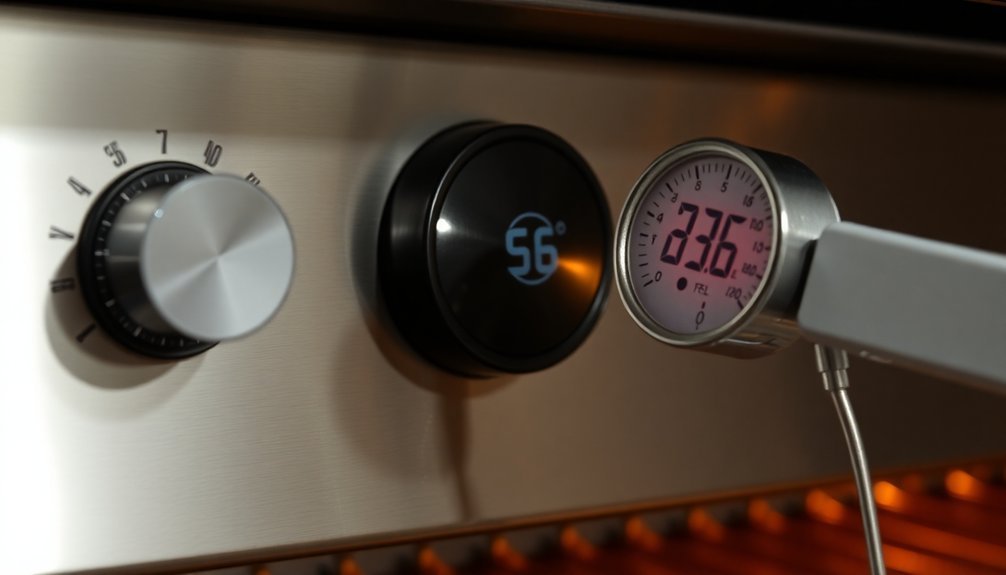
When your oven's temperature reading doesn't match reality, thermostat calibration is likely the culprit. To address this issue, you'll need to verify the actual temperature using an oven thermometer placed on the middle rack. Set your oven to 350°F and let it run for 30 minutes before checking the reading. You should continue taking temperature readings every 15 to 20 minutes to ensure consistent readings.
For digital ovens, you'll need to access the calibration mode through your control panel. Follow your owner's manual carefully, as the button combinations vary by model. If you have an analog oven, you can adjust the temperature by removing the knob and turning the calibration screws – clockwise to decrease temperature, counterclockwise to increase it.
| Calibration Step | Digital Oven | Analog Oven |
|---|---|---|
| Initial Check | Use thermometer | Use thermometer |
| Access Method | Control panel | Remove knob |
| Adjustment Type | Button input | Screw turning |
| Increment Size | By degrees | 1/8 turn |
| Verification | Press start | Retest temp |
If your oven temperature varies by more than 35 degrees Fahrenheit from its setting, it's best to contact a professional technician rather than attempting further adjustments yourself.
Ventilation System Failures
Your oven's ventilation system plays a crucial role in maintaining consistent temperatures, but common issues like blocked air vents can seriously disrupt its performance.
You'll notice signs of blocked vents when food cooks unevenly or takes longer than usual to reach the desired temperature. Restricted airflow from clogged vents forces your oven to use more energy and power to maintain proper heat.
If your oven's fan motor burns out, you might hear unusual noises or experience complete ventilation failure, requiring immediate professional repair to prevent further damage to your appliance.
Blocked Air Vents
Poor ventilation caused by blocked air vents can seriously compromise your oven's performance and cooking results. Your oven's vents become blocked through various means, including food spills, grease buildup, and environmental factors like dust and construction debris. Similar to over the range hoods, proper ventilation helps remove steam, grease, and food odors from your cooking space. When these blockages occur, you'll notice uneven cooking, longer baking times, and disappointing results in your baked goods.
| Issue | Cause | Impact |
|---|---|---|
| Uneven Heat | Restricted Airflow | Food cooks inconsistently |
| Extended Cooking | Poor Ventilation | Higher energy costs |
| Component Stress | Overworking | Premature appliance failure |
To maintain proper airflow, you'll need to implement regular vent maintenance. Start by conducting visual inspections with a flashlight to spot potential blockages. Remove loose debris using a vacuum cleaner or soft-bristled brush, and tackle stubborn deposits with appropriate cleaning solutions. Don't forget to establish a regular maintenance schedule to prevent future blockages. Proper ventilation isn't just about better cooking results—it's vital for your oven's longevity and efficiency. In gas ovens, it's particularly important for maintaining proper combustion and preventing dangerous gas buildup. By keeping your vents clear, you'll guarantee consistent temperatures and top-notch cooking performance.
Fan Motor Burnout
Over time, fan motor burnout stands as one of the most critical ventilation system failures affecting oven performance. When your oven's fan motor fails, it can't properly circulate hot air throughout the cavity, leading to uneven cooking temperatures and potentially unsafe food preparation.
You'll notice several warning signs when your fan motor is failing. Listen for unusual noises or vibrations coming from the motor area. You might also notice reduced airflow or complete lack of ventilation. If your oven's temperature fluctuates more than usual, it's often a clear indicator of fan motor problems.
Several factors can cause your fan motor to burn out. Excessive heat exposure and continuous operation without proper cooling periods strain the motor.
Power surges and electrical issues can damage internal components, while dust and debris buildup can restrict airflow and accelerate failure.
To address fan motor burnout, you'll need to inspect the motor and its surroundings for visible damage. Test electrical connections with a multimeter to confirm if the motor needs replacement.
Once you've installed a new motor, maintain it properly by regularly cleaning dust and debris to prevent future failures and guarantee consistent oven temperatures.
Heating Element Wear
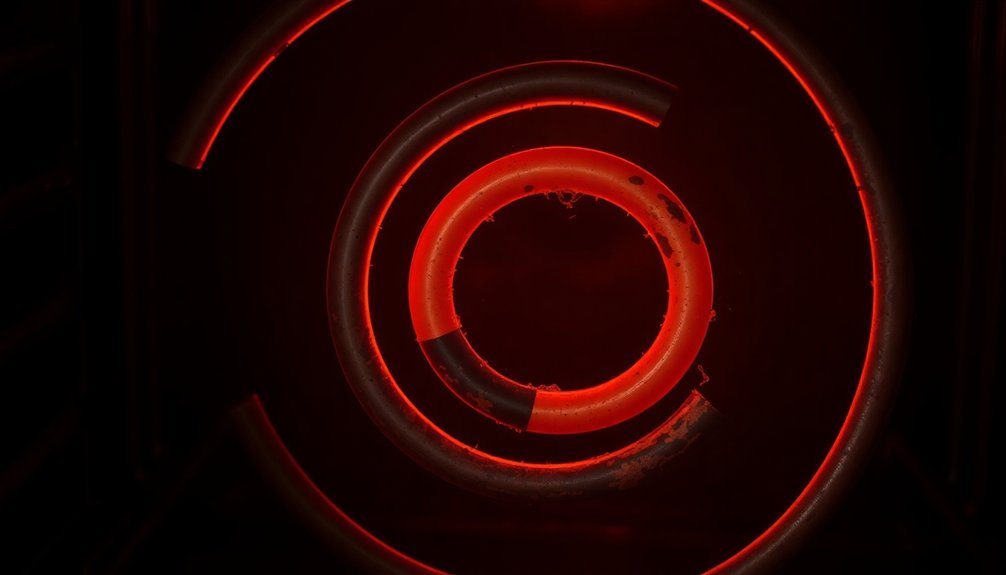
While heating elements are designed to last for years, they can gradually deteriorate and substantially impact your oven's temperature consistency. When your heating element starts to fail, you'll notice that your oven won't maintain its set temperature throughout the cooking process, leading to undercooked or overcooked food.
You can identify a failing heating element through visual inspection. When your oven's on, the element should glow bright red. If it's not glowing or only partially glowing, you're likely dealing with a worn-out component.
Additionally, if you notice your oven's temperature dropping markedly without recovering to the set temperature, your heating element may be the culprit.
Don't ignore these signs, as a faulty heating element will continue to affect your oven's efficiency and may cause further malfunctions. If you suspect heating element wear, you can troubleshoot by checking for loose connections and using a multimeter to test for electrical continuity.
When you confirm the heating element is failing, it's best to replace it promptly. Make sure the new element is properly installed to prevent future temperature consistency issues and maintain your oven's peak performance.
Sensor and Capillary Malfunctions
Beyond heating element issues, temperature sensors and capillary tubes play a vital role in maintaining your oven's temperature accuracy. When these components malfunction, you'll notice uneven cooking, longer cooking times, and frustrating temperature fluctuations. A faulty sensor might not properly communicate with your oven's thermostat, while damaged capillary tubes can cause wild temperature swings.
| Component | Common Issues | Solutions |
|---|---|---|
| Temperature Sensor | Incorrect readings, overheating | Test with multimeter, replace if faulty |
| Capillary Tube | Misalignment, damage from heat | Check installation, secure bulb properly |
| Thermostat Connection | Poor signal transmission | Inspect wiring, verify proper connections |
You can diagnose sensor problems using a multimeter set to the lowest ohm rating. If you get no reading or incorrect resistance values, you'll need to replace the sensor. For capillary tubes, verify the bulb is securely clipped inside your oven and properly insulated, especially in gas ovens. Regular maintenance helps prevent these issues, but if you're experiencing persistent temperature inconsistencies, it's worth having a professional technician inspect both components for proper functionality.
Proper Airflow Maintenance
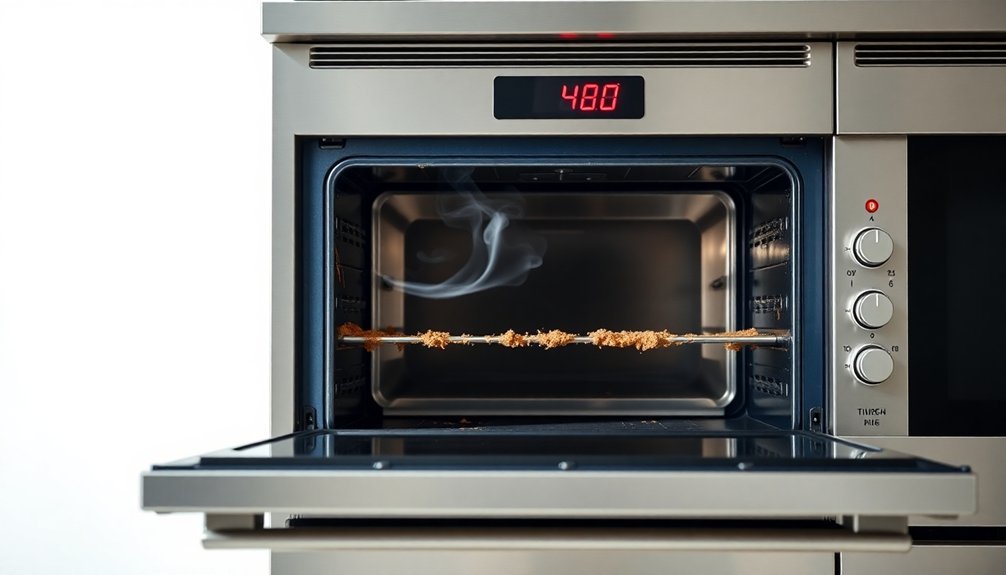
You'll need to regularly check your oven's fans and vents for any debris or buildup that could restrict proper airflow.
Clearing away blockages from fan blades guarantees they can efficiently circulate hot air throughout your oven's chamber.
Remove any obstructions from both internal and external vents to maintain consistent temperature distribution during cooking.
Removing Fan Blockages
A well-maintained oven fan is essential for achieving consistent cooking temperatures. If you're experiencing temperature fluctuations, inspect your fan for blockages and clean the blades regularly.
Use a soft brush or vacuum to remove dust, and tackle stubborn residue with a damp cloth, making sure the fan dries completely before operation.
Don't overlook your fan's motor health. Check for electrical issues using a multimeter and inspect wiring for damage. If you discover a faulty motor, you'll need to replace it to restore proper airflow.
While examining the fan, make certain it's set to the correct mode for your cooking needs and verify that the speed settings match your recipe requirements.
Your cooking habits can also affect fan performance. Avoid overcrowding your oven, as this restricts airflow and creates temperature inconsistencies. Leave adequate space between dishes and oven walls, and never cover racks with foil.
Keep your racks clean to prevent food buildup that could impede air circulation. Regular maintenance of these components won't just improve temperature consistency—it'll also extend your oven's lifespan and enhance your cooking results.
Clearing Vent Obstructions
While fan maintenance plays a key role in oven performance, proper ventilation serves as the backbone of temperature consistency. Without adequate airflow, hot air becomes trapped, leading to uneven heating and temperature fluctuations throughout your oven.
You'll need to regularly inspect and clear your oven's ventilation system to maintain top-notch performance. Start by checking for common obstructions like grease buildup, food debris, and dust accumulation in the vents.
Use a vacuum or brush to remove loose debris, and thoroughly clean any grease or food residue that could cause future blockages.
Don't forget to check and clean or replace ventilation filters as needed. If you're experiencing persistent temperature issues, verify your oven has proper clearance and isn't blocked by nearby objects.
For stubborn or complex blockages, you may need professional assistance to restore proper airflow.
To prevent future ventilation problems, implement a regular maintenance schedule. Consider bi-annual deep cleaning of your ventilation system and install high-quality filters.
Bakeware Placement Effects
Proper placement of bakeware in your oven stands out as one of the most critical factors for achieving consistent baking results. The center rack provides ideal all-around temperatures for most baked goods, while lower racks work better for items needing crunchy undersides, and upper racks help brown toppings effectively.
You'll need to adjust rack positions based on your bakeware's depth and size. Place deep pans like Bundt cakes in the bottom third of the oven, while shallow pans work well on the middle rack.
Always maintain two inches of clearance around your pans for proper air circulation, and don't crowd multiple pans together.
Your bakeware's material and size substantially impact temperature distribution. Dark pans heat up faster than light ones, so you'll need to lower temperatures accordingly.
In smaller ovens, you'll want to avoid using large pans as they can cause uneven cooking, with crusts hardening before centers finish baking.
For specific baking needs, use the upper rack for toasting and browning, center rack for cookies and layer cakes, and bottom rack for roasting meats.
If you're not using a convection oven, don't forget to rotate your baking sheets halfway through for even results.
Seasonal Temperature Variations
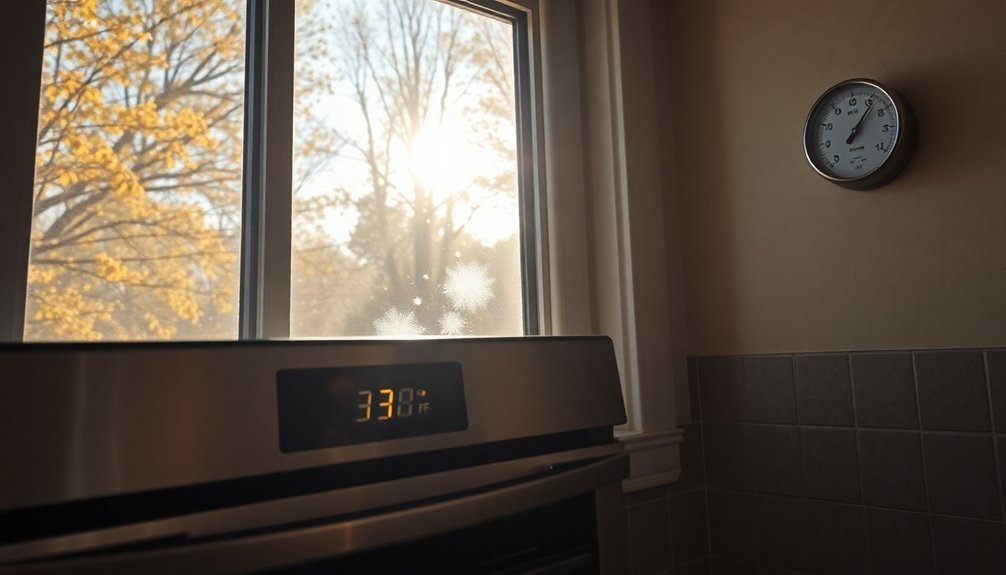
Seasonal changes in temperature and humidity can wreak havoc on your baking results, especially when making bread. When humidity levels rise, your flour absorbs more moisture from the air, which can make your dough too wet and difficult to shape.
Similarly, higher temperatures can cause yeast to become overactive, leading to rapid rising that compromises flavor development.
You'll need to make adjustments to your recipes throughout the year to maintain consistency. During humid seasons, you might need to reduce the amount of water in your recipes, while in drier months, you may need to add more. Pay attention to how your dough feels and looks rather than strictly following recipe measurements.
Your oven's performance can also vary with seasonal changes. Temperature fluctuations become more noticeable as your oven works harder to maintain its set temperature in extreme weather.
You can combat these variations by using a reliable oven thermometer and adjusting your settings accordingly. Consider using a cast iron cooker to help stabilize temperatures, and always allow extra preheating time during temperature extremes. If you're using convection settings, remember to adjust both your temperature and cooking times to compensate.
Professional Maintenance Tips
You'll get the most from your oven by scheduling professional inspections every 6-12 months, which helps catch potential issues before they affect your cooking results.
When working with your service technician, insist on a safety-first approach that includes checking gas lines, electrical connections, and temperature controls before any repairs begin.
Your technician should use specialized diagnostic tools to test heating elements, sensors, and control boards to pinpoint the exact cause of temperature inconsistencies.
Regular Inspection Schedule
A well-structured inspection schedule forms the backbone of professional oven maintenance. By following daily, monthly, and seasonal checkups, you'll guarantee your oven maintains consistent temperatures and operates efficiently.
Start with immediate spill cleanup and regular exterior wipes to prevent residue buildup that can affect temperature regulation.
Your monthly maintenance routine should focus on deep cleaning using baking soda and vinegar solutions. Don't forget to inspect door hinges and gaskets, as these components directly impact heat retention and temperature consistency. Replace worn racks and filters to maintain proper heat distribution.
Key inspection points for temperature consistency include:
- Testing all cooking functions with an oven thermometer
- Checking door seals for gaps or damage
- Verifying proper calibration of temperature settings
Schedule professional service every six months, and don't skip the annual technician inspection. These expert evaluations can identify potential issues before they affect your oven's temperature consistency.
Remember to thoroughly clean your oven before peak usage periods, such as holidays or special events, when temperature precision matters most. Professional maintenance isn't just about cleanliness—it's essential for maintaining accurate temperature control and extending your oven's lifespan.
Safety-First Repair Approach
Safety protocols form the cornerstone of any oven repair or maintenance procedure. Before attempting any work on your oven, you'll need to unplug it completely and let it cool down to prevent electrical shock and burns.
Don't forget to wear protective gear, including gloves and safety goggles, especially when handling cleaning chemicals or sharp components.
When dealing with temperature consistency issues, you shouldn't hesitate to call a professional if the problem extends beyond basic troubleshooting. A qualified technician should handle complex repairs, particularly those involving the temperature sensor, thermostat, or electronic control board. They'll conduct thorough servicing that includes a detailed inspection of all components.
While waiting for professional help, you can take preventive measures by maintaining proper ventilation during cleaning and regularly inspecting your oven's components. Check the door seals for wear, examine heating elements for damage, and verify the oven fans are functioning correctly.
Remember to test the oven's temperature regularly using a reliable thermometer to identify any inconsistencies early. Always follow your manufacturer's specific maintenance instructions and keep the user manual handy for reference.
Diagnostic Testing Methods
Through proper diagnostic testing, maintaining consistent oven temperatures becomes a systematic process. Start by gathering essential tools, including an air probe with grate clip, oven thermometer, and a smart device like the Blue Dot or ChefAlarm for automated temperature tracking. These instruments will help you accurately measure and monitor your oven's performance over time.
Begin testing by preheating your oven to 350°F and allowing it to stabilize for 20 minutes. You'll need to observe temperature fluctuations for at least 30 minutes while recording maximum and minimum readings. This data helps determine your oven's average operating temperature and identifies potential consistency issues.
Key steps for effective diagnostic testing:
- Compare your oven's set temperature with actual readings using multiple measurement points
- Document temperature variations during extended cooking periods
- Test different rack positions to identify hot spots or cold zones
If you discover temperature discrepancies, you can adjust your oven's calibration using built-in features. For digital ovens, access the control panel settings; for manual controls, locate the calibration screw.
Regular testing and maintenance will help guarantee your oven maintains consistent temperatures for ideal cooking results.
Frequently Asked Questions
Can Using Self-Cleaning Mode Damage My Oven's Temperature Controls?
There's no direct evidence that self-cleaning mode damages temperature controls. Your oven is designed to safely handle the high temperatures, but you'll want to follow manufacturer guidelines to maintain proper operation.
Does Cooking Multiple Dishes Simultaneously Affect Temperature Accuracy More Than Single Dishes?
Yes, when you're cooking multiple dishes at once, you'll experience greater temperature fluctuations than with single dishes. The increased oven load affects air circulation and heat distribution, making it harder to maintain consistent temperatures.
How Do Power Fluctuations in My Home Affect Oven Temperature Consistency?
Power fluctuations in your home can disrupt your oven's heating elements and sensors, causing temperature inconsistencies. You'll notice voltage drops and surges affecting heating cycles, potentially leading to uneven cooking and damaged components.
Will Installing an Aftermarket Thermometer Impact My Oven's Temperature Readings?
No, installing an aftermarket thermometer won't affect your oven's actual temperature. It'll just give you more accurate readings than your built-in thermometer, especially when placed properly on the middle rack.
Can Certain Cleaning Products Damage the Oven's Temperature Sensors?
Yes, harsh cleaning chemicals can damage your oven's temperature sensors. You'll want to avoid abrasive cleaners and strong chemical solutions. Instead, use gentle cleaners like vinegar or mild soap to protect your sensor's functionality.
In Summary
Your oven's temperature fluctuations don't have to remain a mystery. By checking door seals, calibrating thermostats, and ensuring proper ventilation, you'll maintain more consistent temperatures. Remember to inspect heating elements regularly and position your bakeware correctly. If you're still experiencing issues, don't hesitate to call a professional. Regular maintenance will extend your oven's life and improve your cooking results.

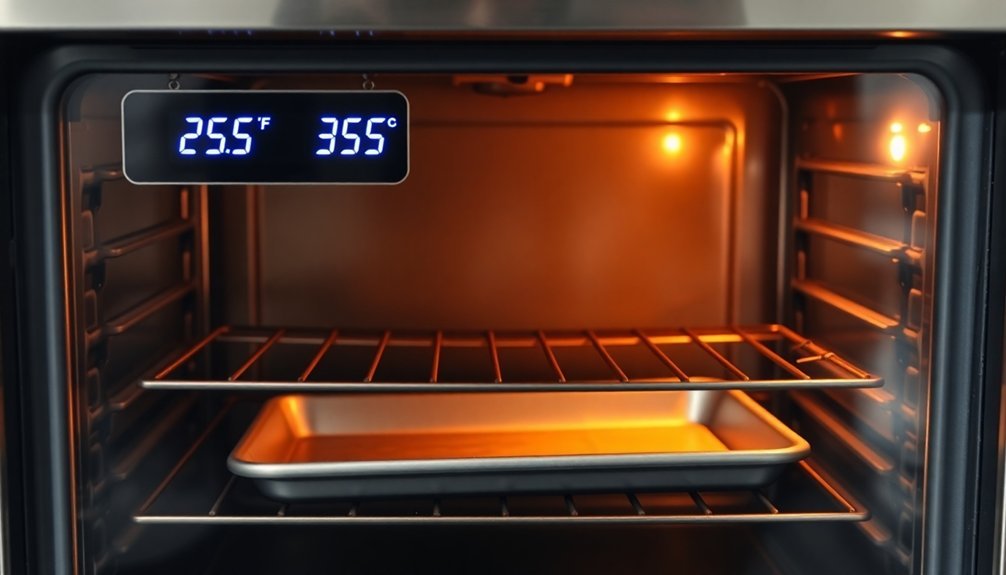



Leave a Reply